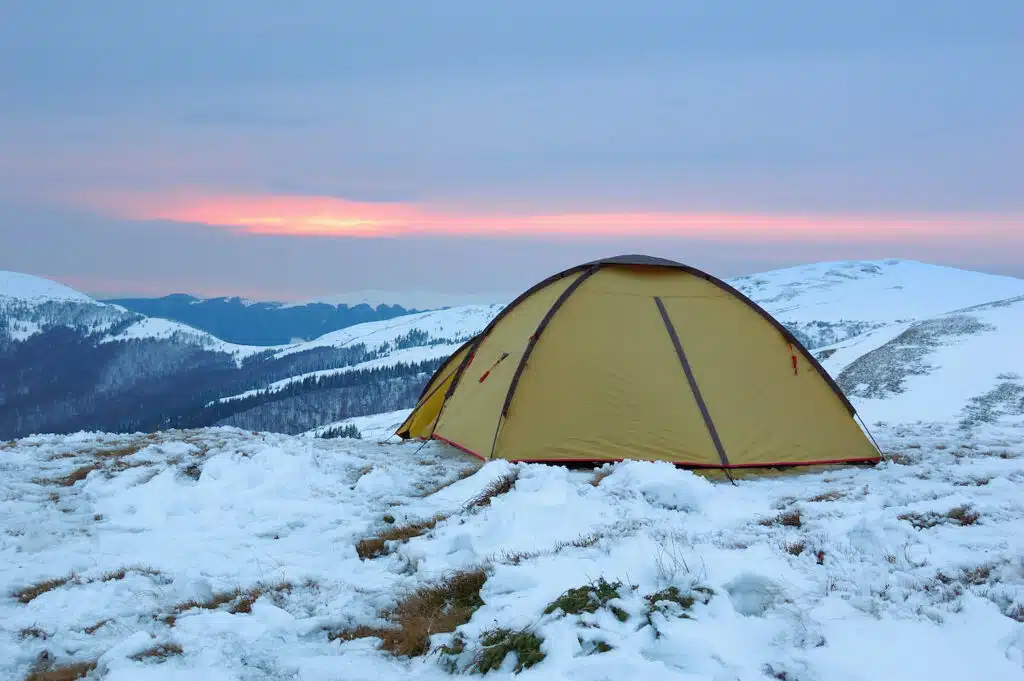If you make a purchase using links in this article, I could receive a commission. Please see my Privacy Policy for information.
Want to wake up in a quiet winter wonderland? Winter camping sounds like a magical experience, but how do you keep warm when the temperature outside your tent is nearly freezing? When a campfire just won’t cut it, here are a few tips on how to insulate a tent for winter camping.

You will also want to see our list of the best safe tent heaters to help you stay warm.
If you’re worried about cooler temperatures, but not necessarily snow and ice, check out our packing guide for Fall camping.
Picking the Right Tent for Winter Camping
First off, you’ll want to pick the right tent for your winter camping trip. There’s no point insulating a tent if it’s not going to fare well in wintery conditions.
When camping in the winter, you’ll need a four-season tent rather than a three-season tent.
The main difference between four-season and three-season tents is their inner lining. Three-season tents are more lightweight with a mesh canopy for breathability, while four-season tents have a thicker inner lining to keep you warm.
Four-season tents may also have more pegs and anchor ropes for added stability.
Another thing to consider is the size of your tent. When picking a tent, try to get one as small as possible. While it may be more comfortable for two people to sleep in a four-person tent, it’s not worth wasting any heat on the added space. The smaller the tent, the more heat that stays near you.
For a larger tent with a stove pipe that is meant to use with a tent stove wood heater, this hammock hot tent is the one that you want. However, it’s not as portable.
Build a Wind Break
Before you go about insulating the inside and outside of your tent, you’ll want to ensure you set up camp correctly. Setting up your tent by a natural windbreak like a large rock or a tree will help reduce icy winds from reaching inside your tent.
If you can’t find something that works as a natural windbreak, bring along a canopy or windscreen, which you can set up to stop the wind from reaching your tent.
A portable ice shelter is also an idea to use when camping in cold weather. They are made for protecting you from icy conditions.
You could also build a windbreak out of snow if you’re camping in particularly icy conditions.
Clear the Ground Where You are Camping
Before you set up your tent, pick a spot that’s flat and clear from snow. Setting up camp on top of snow isn’t a good idea, as the snow will melt, causing puddles around your tent. The snow could also refreeze and create icy bumps which will make it tough to get comfortable.
It is very smart to bring along a portable snow shovel for easy campsite maintenance.
How to Insulate the Walls and Exterior of a Tent
You will want to start by picking the right material for insulating the interior and exterior of your tent. Think about insulating your tent the same way you think about insulating your house. You’ll want a material with plenty of air pockets so air can get trapped inside.
You’ll also want something reflective, so any body heat lost is returned back to you.
The perfect material for insulating a tent is reflective foam. This popular insulative material is relatively inexpensive and is flexible enough to fit around the inside or outside of a tent. It’s also reflective on both sides to reduce heat loss.
This is the type of insulation that many van campers and truck campers use, too. So you can use it for many purposes.
One of the biggest problems with insulating the walls of a tent is it’s tricky and takes time. You can try duct taping some of the insulation to the walls and ceiling if you find the reflective foam won’t stay put.
Some campers prefer to insulate the outside of their tent with reflective material. However, this is less effective, as the foam will reflect the heat away from the tent rather than keep it inside.
That being said, insulating the exterior of a tent will help somewhat and is better than no insulation whatsoever.
We found this video interesting of using a smaller tent inside a larger tent to create an insulated interior. As you’ll see, it didn’t really work too well. But it’s an interesting concept, especially if you are camping in rain, sleet or snow.
How to Insulate the Floor of a Tent
Probably the most important part of a tent to insulate is the floor. It is where you will sleep and spend your most time.
After clearing the ground of ice and snow, you may want to put a canopy or sheet down below your tent for added insulation.
Again, you’ll want to use reflective foam to insulate the floor of your tent. Double-sided foam is the best, as it will reflect your body heat and reflect any cold air rising from the ground.
When placing the reflective foam, ensure it goes a few inches up the wall and doesn’t just cover the floor. Air currents will rise from around the edge of the foam, so protecting the bottom of the tent walls is crucial.
You might think a raised bed will help keep you warm, but this isn’t the case. A cot or camp bed may be more comfortable, but the extra space between you and the ground means more space for air currents to move.
Something low to the ground, like a camping air mattress, is a better idea for a good night’s sleep.
More Ways to Stay Warm While Winter Camping
If you are worried that insulating your tent won’t be enough, or you are just looking to keep warm another way, there are a few more ideas to try. Instead of insulating the tent, you can try insulating yourself!
Consider picking up some thermal clothes and a winter sleeping bag rated for 0 degrees Fahrenheit (it’s surprisingly affordable!) to help keep the cold out on long winter nights.
Keeping your extremities warm is also wise, so consider buying a pair of thermal socks.
You could also try heating your tent from the inside. You can try buying heat packs to place inside your sleeping bags. Although, a more effective alternative to heat packs is a hot water bottle.
If you’re worried you’ll still be cold, you might want to grab this tent heater. It’s among the most popular and most effective. You can see how it works in the video below:
Tent heaters come in all shapes and sizes and work similarly to a standard space heater. However, tent heaters are potentially dangerous if misused as they could start a fire. Consider purchasing a tent heater with an automatic shut-off when tipped over for added safety.
We use a Jackery for power while off the grid and were able to run a small heater for about three hours on a full charge. The solar-powered mini generator can be refueled by sunlight the next day.
For motorhome camping, we have 28 proven ways to stay warm in an RV.
You will also want to know how to use winter skirting to insulate your camper and save money on fuel costs.
